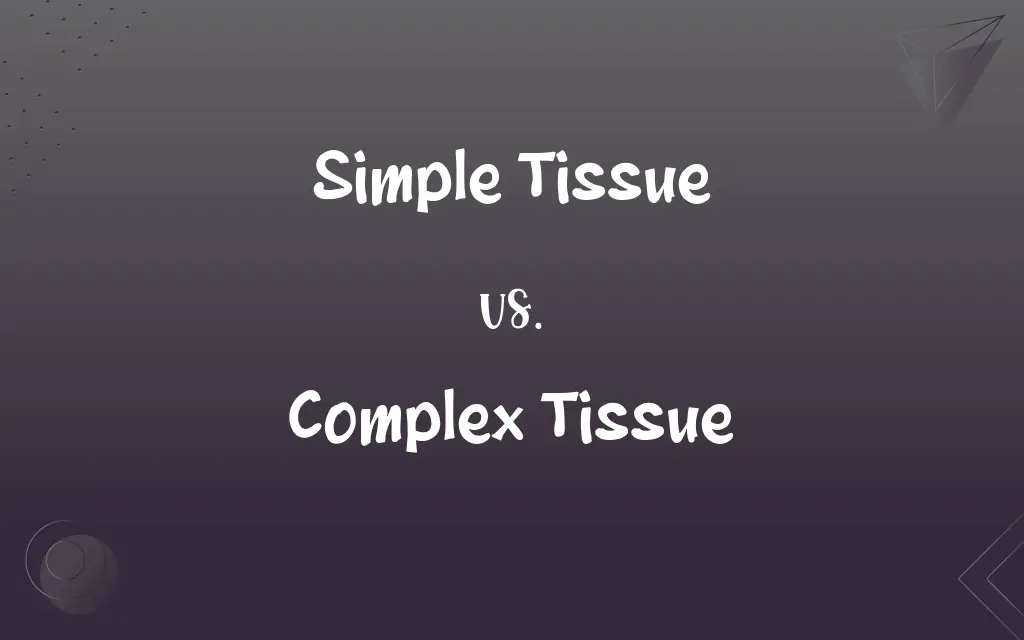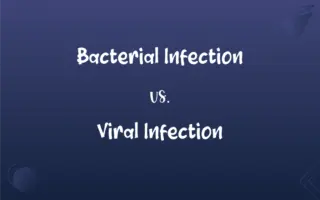Simple Tissue vs. Complex Tissue: What's the Difference?
Edited by Janet White || By Harlon Moss || Updated on October 5, 2023
Simple tissue consists of similar cell types performing the same function, while complex tissue has different cell types working together to perform multiple functions.

Key Differences
In botanical anatomy, simple tissue and complex tissue refer to the cellular structures found within plants that perform various functions. Simple tissue comprises similar types of cells and has a unified function. These tissues are predominantly parenchyma, sclerenchyma, and collenchyma, each serving different but individual functions within the plant, such as storage, photosynthesis, and mechanical support.
Complex tissue, on the other hand, consists of different types of cells grouped together, collaboratively performing multiple functions. Complex tissues, notably xylem and phloem, play crucial roles in the transport of water, nutrients, and organic materials throughout the plant. The diversified cell types within complex tissues enable the execution of intricate and multifaceted tasks essential for plant growth and survival.
The notable simplicity in the structure and function of simple tissue can be contrasted with the multifunctional and multicellular nature of complex tissue. Simple tissue, often forming a bulk of the plant’s body, facilitates basic yet vital functions, including providing elasticity and tensile strength, or aiding metabolic activities such as photosynthesis, secretion, and storage.
Complex tissue, conversely, tends to fulfill transportative and supportive roles within the plant, ensuring that water, minerals, and food are efficiently conveyed to all parts, thereby maintaining the plant’s physiological stability and structural integrity. The diversity of cell types within complex tissues underscores its capability to execute a variety of functions in a coordinated manner.
In summary, while both simple tissue and complex tissue are crucial to the sustenance and development of plants, they diverge significantly in their cellular composition and functional roles. Simple tissue, with its uniform cellular structure, undertakes specific, isolated functions, whereas complex tissue, with its varied cell types, accomplishes multiple, interconnected tasks, affirming their vital roles in plant biology.
ADVERTISEMENT
Comparison Chart
Cellular Composition
Made up of similar types of cells.
Comprises different types of cells.
Function
Performs a single, specific function.
Conducts multiple, interrelated functions.
Examples
Includes parenchyma, sclerenchyma, collenchyma.
Involves xylem and phloem.
Structural Complexity
Generally less structurally complex.
More structurally complex due to varied cells.
Role in Plant
Involved in basic structural and metabolic functions.
Primarily involved in transport within the plant.
ADVERTISEMENT
Simple Tissue and Complex Tissue Definitions
Simple Tissue
Involves in providing mechanical support.
Collenchyma, a simple tissue, provides mechanical support and elasticity to plants.
Complex Tissue
Primary function involves transport within plants.
The complex tissue ensures efficient transport of water and nutrients in plants.
Simple Tissue
A tissue composed of similar types of cells.
Parenchyma, a type of simple tissue, is crucial for storage and photosynthesis.
Complex Tissue
Contains more than one type of cell.
The complex tissue amalgamates various cell types to perform multiple functions.
Simple Tissue
Found throughout the plant body.
Simple tissue forms a substantial part of leaves, stems, roots, and fruits.
Complex Tissue
Involves different types of cells working together.
Complex tissue like xylem includes tracheids, vessel elements, and parenchyma cells.
Simple Tissue
Has less structural complexity compared to complex tissue.
Simple tissue, with its uniform cell type, showcases lesser structural complexity.
Complex Tissue
Divided mainly into xylem and phloem.
The complex tissue is differentiated into xylem and phloem, each with distinct functions.
Simple Tissue
Primarily involves in fundamental metabolic functions.
The simple tissue assists in the basic metabolic and storage activities of plants.
Complex Tissue
Present in specific areas of plants.
Complex tissue like phloem is found associated with the vascular bundles in plants.
FAQs
What is complex tissue?
Complex tissue comprises various cell types and performs multiple interconnected functions in plants.
What function does simple tissue perform?
Simple tissue performs specific functions like storage, photosynthesis, or providing mechanical support.
Can you name the primary complex tissues in plants?
The primary complex tissues in plants are xylem and phloem.
Is complex tissue involved in transport in plants?
Yes, complex tissue plays a crucial role in transporting water, nutrients, and organic materials in plants.
Is providing elasticity a function of simple tissue?
Yes, collenchyma, a simple tissue, provides elasticity to plants.
Are complex tissues vital for plant growth?
Yes, complex tissues like xylem and phloem are crucial for transporting nutrients and water, thus aiding plant growth.
What role do the varied cells in complex tissue play?
The varied cells in complex tissue collaborate to perform interconnected tasks like transport and support within plants.
What is simple tissue?
Simple tissue consists of similar types of cells and performs a specific function in plants.
What does xylem transport in plants?
Xylem mainly transports water and dissolved minerals upward from roots to other parts of the plant.
Can simple tissues be found in all parts of the plant?
Yes, simple tissues are present in various parts like roots, stems, leaves, and fruits.
Can simple tissues perform multiple functions together?
No, simple tissues typically perform specific, isolated functions.
What cells are found in complex tissue like xylem?
Xylem comprises various cells like tracheids, vessel elements, xylem parenchyma, and xylem fibers.
Is simple tissue involved in photosynthesis?
Yes, parenchyma, a type of simple tissue, is actively involved in photosynthesis.
What is a notable feature of complex tissue?
A notable feature of complex tissue is its ability to perform multiple, interrelated functions.
What is an example of simple tissue?
An example of simple tissue is parenchyma, which is involved in storage and photosynthesis.
How does phloem, a complex tissue, benefit plants?
Phloem transports organic nutrients, especially sugars, throughout the plant.
Are collenchyma and sclerenchyma simple tissues?
Yes, collenchyma and sclerenchyma are types of simple tissues.
Does simple tissue have the same type of cells?
Yes, simple tissue consists of similar types of cells.
Do complex tissues support mechanical functions?
Yes, complex tissues like xylem also provide mechanical support to plants.
What is the role of sclerenchyma in plants?
Sclerenchyma, a simple tissue, provides mechanical strength to plants.
About Author
Written by
Harlon MossHarlon is a seasoned quality moderator and accomplished content writer for Difference Wiki. An alumnus of the prestigious University of California, he earned his degree in Computer Science. Leveraging his academic background, Harlon brings a meticulous and informed perspective to his work, ensuring content accuracy and excellence.
Edited by
Janet WhiteJanet White has been an esteemed writer and blogger for Difference Wiki. Holding a Master's degree in Science and Medical Journalism from the prestigious Boston University, she has consistently demonstrated her expertise and passion for her field. When she's not immersed in her work, Janet relishes her time exercising, delving into a good book, and cherishing moments with friends and family.































































